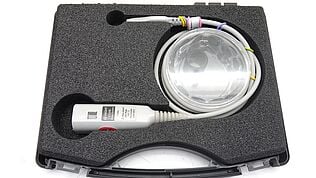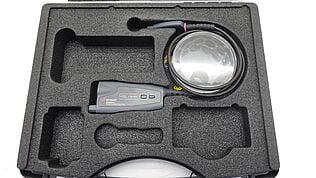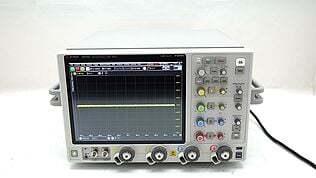- Introduction
- Understanding Digital Oscilloscopes
- Key Features
- How a Digital Oscilloscope Works
- Signal Capture
- Data Processing
- Display
- Applications of Digital Oscilloscopes
- Research and Development
- Manufacturing
- Repair and Maintenance
- Education
- Choosing the Right Digital Oscilloscope
- 1. Bandwidth: Your Window to Frequency
- 2. Sample Rate: The Detail in Your Data
- 3. Channel Count: Multiplying Your Perspectives
- 4. Memory Depth: Capturing More of Your Signal
- Conclusion
- Whenever You’re Ready, Here Are 5 Ways We Can Help You
A group of engineers is working on the latest electric car, aiming to squeeze out every bit of power and efficiency from the battery. They turn to a digital oscilloscope, but not just for the usual checks. They're diving deep into the car's electrical system, looking at how the battery behaves when it charges and powers the car.
With the oscilloscope, they catch tiny glitches and noise in the system that you'd never see otherwise. By fixing these electrical problems, they make the car's battery not just better, but also more reliable.
Understanding Digital Oscilloscopes
A digital oscilloscope, often referred to as a Digital Storage Oscilloscope (DSO), is an electronic test instrument that allows you to observe varying signal voltages in a digital format. Unlike analog oscilloscopes that use continuous waveforms, digital oscilloscopes digitize the input signal, allowing for more complex analysis and storage of electrical signals.
Key Features
Digital oscilloscopes come packed with features that make them powerful tools for analysis:
- Digital storage: You can store and analyze waveforms and data at your convenience, a feature that analog oscilloscopes lack.
- Advanced measurement capabilities: Measure voltage, frequency and phase with high precision.
- Waveform analysis: Perform complex mathematical calculations and Fourier analysis on signals.
- User interface: Interactive menus and color displays make operation intuitive and data interpretation easier.
- Connectivity: Modern DSOs offer connectivity options like USB, Ethernet, and Wi-Fi for data sharing and remote control.
| Key Takeaway |
|---|
| Digital oscilloscopes offer an unique view into the electrical signals that drive technology, providing the clarity and detail necessary for innovation and troubleshooting. Their ability to accurately capture, analyze, and display complex waveforms makes them vital tools. |
Maximize Your Budget with Keysight's Refurbished Oscilloscopes
How a Digital Oscilloscope Works
Knowing how a digital oscilloscope works helps clarify how it can show and analyze complex electrical signals. Let's dive deeper into each stage to appreciate the sophistication behind this indispensable tool.
Signal Capture
At the heart of a digital oscilloscope's operation is signal capture. This initial phase is crucial, as it sets the stage for everything that follows. Here’s a detailed look at the process:
- Probe connection: You connect the probe to the point of interest in your circuit. This is your oscilloscope's physical interface with the electrical signal you wish to analyze.
- Signal sampling: The oscilloscope samples the analog signal at precise intervals, determined by its sampling rate. This rate is vital because, according to the Nyquist theorem, it must be at least twice as high as the highest frequency component of the signal to accurately reconstruct the waveform.
- Analog-to-digital conversion (ADC): The sampled analog signals are converted into digital data. This conversion is facilitated by the ADC, a critical component that determines the oscilloscope's resolution. For instance, an 8-bit ADC provides 256 discrete values of signal amplitude, whereas a 12-bit ADC can differentiate 4096 values, offering a more detailed signal representation.
Data Processing
After signal capture, the digital oscilloscope processes the digitized data. This stage is where the raw data transforms into actionable information:
- Waveform reconstruction: The digital data points are interconnected to reconstruct the waveform for display. This process involves various algorithms that ensure the waveform accurately represents the sampled signal.
- Mathematical analysis: Beyond mere visualization, the oscilloscope performs mathematical operations on the digitized waveform. This includes basic calculations like peak-to-peak voltage, as well as more complex analyses such as Fast Fourier Transforms (FFT) for frequency domain analysis.
- Measurement and statistics: Digital oscilloscopes automatically measure various waveform parameters, such as frequency, period, rise time, and more. They can also provide statistical analysis over time, offering insights into signal stability and variation.
Display
The culmination of the digital oscilloscope's process is the display:
- Visual representation: The processed signal is visually represented on the oscilloscope’s screen. Modern oscilloscopes use high-resolution, color displays that not only show the waveform but can also highlight different aspects of the signal, such as anomalies or specific frequency components, using color coding or shading.
- User interface: Alongside the waveform display, the screen also serves as an interactive interface. Users can adjust settings, change how data is displayed, and interact with the waveform directly, such as zooming in on specific segments or adjusting the time base and voltage scales for a better view.
- Data storage and sharing: Many digital oscilloscopes allow you to save waveform data directly from the display. This feature enables further analysis, reporting, or sharing with colleagues. Connectivity options such as USB, Ethernet, or Wi-Fi enhance this capability, allowing for seamless integration into workflows and collaborative projects.
By intricately combining these stages—signal capture, data processing, and display—a digital oscilloscope not only serves as a tool for observing electrical signals but also as a comprehensive analysis platform.
It offers a deep dive into the behavior of electrical circuits, empowering engineers and technicians with the insights needed to design, troubleshoot, and optimize with unparalleled precision and efficiency.

Applications of Digital Oscilloscopes
Digital oscilloscopes have changed the way professionals approach the measurement, analysis, and troubleshooting of electronic signals.
Their versatility and precision make them indispensable tools beyond the typical applications. Let's explore their widespread utility.
Research and Development
In the field of R&D, digital oscilloscopes are invaluable. They offer engineers and scientists the precision required for cutting-edge innovation. This allows them to do:
- Prototype testing: Assess the functionality of new designs under different conditions.
- Signal integrity analysis: Ensure that signals maintain their integrity throughout the system (this is crucial for high-speed digital designs).
- Timing Analysis: Understand the timing relationships between various parts of an electronic system to optimize performance.
Manufacturing
In manufacturing, it is important to ensure product quality while maintaining efficiency. Digital oscilloscopes contribute to this in many ways.
- Automated testing: Integrate with automated test equipment to perform comprehensive quality checks.
- Fault diagnosis: Quickly identify and diagnose issues on the production line, minimizing downtime.
- Process optimization: Monitor manufacturing processes in real time to optimize performance and reduce waste.
Repair and Maintenance
Digital oscilloscopes are the go-to tools for technicians tasked with keeping electronic equipment running smoothly, thanks to their ability to:
- Troubleshoot complex systems: Pinpoint the exact location of faults in intricate electronic systems.
- Performance verification: Ensure repaired equipment meets the original performance specifications.
- Preventive maintenance: Identify potential issues before they lead to equipment failure.
Education
In educational settings, digital oscilloscopes play a critical role in shaping the next generation of engineers and technicians by:
- Demonstrating principles: Offers a hands-on approach to learning about electronic signals, circuit design, and signal processing.
- Laboratory experiments: Allows students to conduct experiments, analyze results, and learn from real-world signal behavior.
- Advanced research projects: Supports students and researchers in conducting sophisticated research projects that require detailed signal analysis.
Choosing the Right Digital Oscilloscope
Selecting the right digital oscilloscope for your needs involves understanding and weighing several critical specifications. These specs determine the instrument's ability to capture, analyze, and display the signals you're working with. Let's explore what features you should consider when choosing a digital oscilloscope.
1. Bandwidth: Your Window to Frequency
Think of bandwidth as the window through which you can view your signal. It defines the maximum frequency your oscilloscope can accurately measure. Here's what you should keep in mind:
- Match your needs: Ensure the bandwidth exceeds the highest frequency component of the signal you wish to analyze. For digital signals, a good rule of thumb is to choose an oscilloscope with a bandwidth five times higher than the signal's maximum frequency to capture the waveform accurately.
- Future-Proof: Consider potential future applications that may require higher bandwidth to avoid outgrowing your oscilloscope.
2. Sample Rate: The Detail in Your Data
The sample rate, or how frequently the oscilloscope samples the input signal, directly impacts the accuracy of your signal representation. Here's how to assess this factor:
- Higher is better: A higher sample rate provides a more detailed view of your waveform, allowing you to see finer details and transient events you might otherwise miss.
- Nyquist criterion: At a minimum, your oscilloscope should sample at least twice as fast as the highest frequency component of your signal, according to the Nyquist theorem. However, for more complex analyses, a sample rate ten to twenty times higher may be necessary.
3. Channel Count: Multiplying Your Perspectives
The number of channels determines how many signals you can observe and analyze simultaneously. Here's why this matters:
- Complex systems analysis: If you're working with complex systems or need to compare multiple signals, opt for an oscilloscope with more channels. Four-channel oscilloscopes are common, but more specialized units offer even more.
- Integrated digital channels: Some oscilloscopes include digital channels in addition to their analog counterparts, which is especially useful for mixed-signal analysis (analog and digital).
4. Memory Depth: Capturing More of Your Signal
Memory depth is essentially how much of the signal your oscilloscope can remember after capturing it. This is crucial for:
- Longer timeframes: A deeper memory allows you to capture longer stretches of a signal at a high sample rate, which is invaluable for detailed analysis over time.
- Zoom and analysis: With more memory, you can zoom in on parts of your waveform without losing detail, making it easier to spot glitches or anomalies.
When choosing a digital oscilloscope, start by clearly defining what you need to measure and analyze both now and in the foreseeable future. Consider the complexity of the signals, the level of detail you need, and how many signals you'll be working with simultaneously.
| Feature | Importance for You |
| Bandwidth | Essential for capturing fast signals accurately. |
| Sample Rate | Critical for detailed waveform analysis. |
| Channel Count | Choose based on how many signals you need to observe. |
| Memory Depth | Important for analyzing complex or long-duration waveforms. |
Explore Keysight’s Range of Oscilloscopes Today
Select up to 3 instruments to compare
Enable Notifications
In order to use this feature, you need to enable notifications.
Manage notification preferences
Conclusion
Digital oscilloscopes are essential for anyone involved in electronics, offering the ability to accurately observe, analyze, and understand electrical signals.
Remember, the key factors in choosing the right oscilloscope include its bandwidth, sample rate, channel count, and memory depth. These features ensure that the oscilloscope can handle your specific needs, both now and in the future.
If you're looking to equip yourself with high-quality testing instruments without overspending, consider visiting the Keysight Used Equipment Store.
Here, you can find premium, used oscilloscopes, spectrum analyzers, function generators, and multimeters that have passed stringent quality checks.
It's a smart way to get the tools you need without stretching your budget. Explore the Keysight Used Equipment Store today and give yourself the advantage of top-tier equipment at a fraction of the cost.

Whenever You’re Ready, Here Are 5 Ways We Can Help You
- Browse our Premium Used Oscilloscopes.
- Call tech support US: +1 800 829-4444
Press #, then 2. Hours: 7 am – 5 pm MT, Mon– Fri - Talk to our sales support team by clicking the icon (bottom right corner) on every offer page
- Create an account to get price alerts and access to exclusive waitlists.
- Talk to your account manager about your specific needs.








































